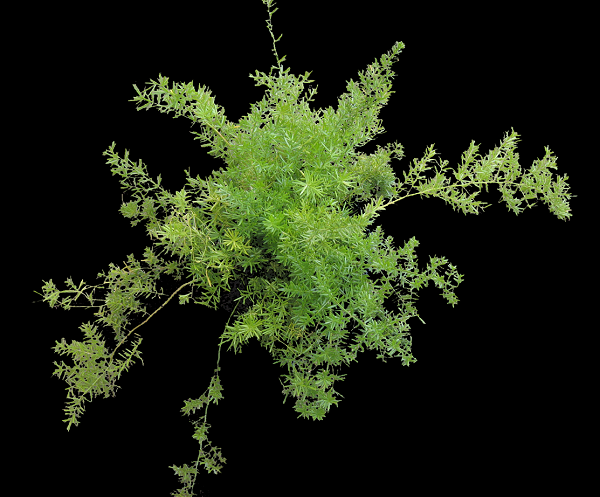The easy-care Asparagus Fern, native to South Africa, is not a true fern at all but rather a member of the lily family. The name Asparagus Fern comes from the fact that the new growth resembles tiny asparagus spears. Asparagus-sprengeri, a cultivar of Asparagus densiflorus is the most popular variety of this plant. It looks beautiful sitting on a table or hanging in a basket. During the summer, it is a perfect plant to hang in a sunny spot on your porch. In the proper location, Asparagus Ferns grow over 2 – 3 feet wide with cascading trailers 2 – 4 feet in length.

The long, graceful vines of an Asparagus Fern are covered in tiny needle-like bright green leaves; an added plus are the small white flowers that eventually turn into red berries. Be careful, because hidden amongst the lush foliage are little sharp thorns that are difficult to see, and the red berries are poisonous.
Care
Light
Asparagus Ferns grow best in bright indirect light coming from an East, West, or North facing window. In lower light the plants grow very slowly.
Water
Allow the top 50% of the soil to dry out before watering. If in doubt, allow the fern to turn pale green before giving it any water. An Asparagus Fern requires more water in the hot summer months, and much drier soil during the cold winter months.
Fertilizer
Feed an Asparagus Fern weekly with a water-soluble plant food when it is actively growing during the summer and monthly during the rest of the year. Always dilute the fertilizer to ½ the recommended strength.
Humidity
Since this plant is not really a fern, it does well in normal to low humidity.
Temperature
Asparagus Ferns enjoy temperatures between 50 – 75°F (10 – 24°C.)
Pests
An Asparagus Fern may get mealy bugs, spider mites, aphids, scale and thrips. These plants do not like pesticides so try using a mild solution of insecticidal soap if there is a problem.
Soil
Use a good and well aerated potting soil that drains quickly. Add some sand, perlite, or peat moss if the soil seems too heavy.
Pot Size
Keep an Asparagus Fern root-bound in small pots to encourage the long, graceful stems to grow.
Pruning
An Asparagus Fern rarely needs to be pruned. If yellow stems appear due to some stress, simply cut them off as close to the soil surface as possible.
Propagation
Asparagus Ferns are propagated by plant division. Try to propagate before the plant starts producing new growth in the spring. The root ball is very tough so have plenty of sharp utensils close by.
Flowering
An Asparagus Fern gets small white flowers that turn into poisonous red berries.
Resting Period
Like many tropical plants, an Asparagus Fern rests during the cooler months. The plant needs very little water during this time.
Toxicity
An Asparagus Fern has a number one or mild toxicity level. If eaten, the red berries can cause digestive problems.
Frequently Asked Questions
1. My asparagus fern has white flowers and red berries. Should I cut them off?
Congratulations, berries & flowers develop when an Asparagus Fern is getting all that it needs. The flowers and berries won’t hurt the plant but may slow down the development of new green growth. Please remember the red berries are poisonous and will cause digestive problems if eaten.
2. When I returned from vacation, some of the vines on my asparagus fern had turned hard and straw-like
The soil in your Asparagus Fern probably dried out a little too much. Cut off the dead vines as close to the soil as possible and drench the plant well. Do not use any fertilizer when the soil is very dry.
3. I have my asparagus plant in my bedroom across from a north- facing window. It hasn’t died, but it hasn’t gotten any new growth.
Your plant probably isn’t getting enough bright light. Try moving your fern directly in front of your north-facing window or better yet, move it to a western or eastern exposure.
4. How do I know when to repot my Asparagus Fern?
An Asparagus Fern literally tells you when it needs a new pot. When the root ball gets too big for its pot, the roots are so strong they can break a plastic container or start forcing the soil up over the edge of any other pot. If this isn’t occurring and you still think the pot is too small, gently pull the fern out of its pot. If the roots have taken on the shape of the pot and there is very little soil left, it’s time for a new container.
Judy Feldstein is the founder of Foliage Unlimited, one of the largest interior plant design, sales, & maintenance companies in Arizona. Judy’s website HousePlant411.com helps plant enthusiasts identify, select, and care for houseplants.
Related Articles & Free Email Newsletter
A Miniature Rose Prospers Outdoors
Geraniums Are Great Outdoor and Indoor Flowering Plants
Plant Profile – Calla Lily Zantedeschia aethiopica or Trumpet Lily




Comment here